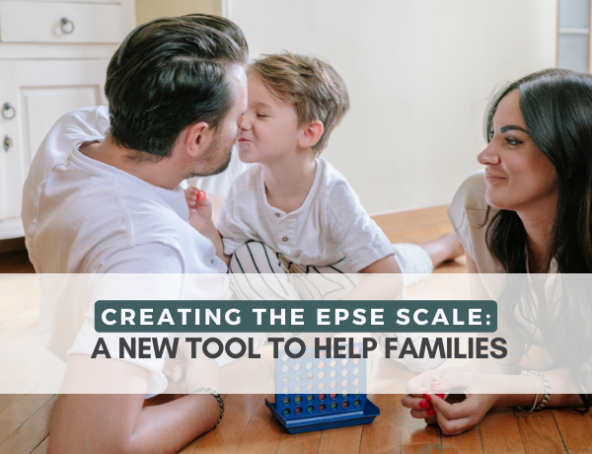Creating the EPSE Scale: A New Tool to Help Families

Creating the EPSE Scale: A New Tool to Help Families
Dr. Aaron Blocher-Rubin, Founder & CEO
In the field of autism support services, there is perhaps no better example of evidence-based treatment than Early Intensive Behavioral Intervention (EIBI), which is often referred to as “intensive ABA” for young children. I have been learning about it and seeing its potential firsthand since my days as a trainee at the Lovaas Institute, where it all began. When I started working in this field, most families could not access EIBI. There were very few qualified providers, and almost no insurance companies or state agencies would pay for it. Nowadays, that has changed dramatically. Studies upon studies have shown that it is perhaps the most effective treatment available today, with the potential to change the course of a child’s development, and the life of a family. As such, it has become a standard recommendation for parents of recently diagnosed children.
While there is no doubt that children can make tremendous progress with EIBI, we must be careful not to overlook just how much we are asking of parents when we recommend these high intensity programs. Over the years, I have seen hundreds of families engage in this effort with mixed results. So much research has focused on whether or not the treatment works when it is done right, but very little has looked at why some families struggle to implement and sustain it. This issue was at the forefront of my mind when I was designing a research study to complete my PhD dissertation.
EIBI providers use many different types of tools and instruments to assess children – their language, self-help abilities, play skills, social interaction levels, and so on. These measures are designed to tell us where the gaps are, so we know how to best focus our efforts as we work with each child. Every major study or book on EIBI also emphasizes how critical parent involvement is, but there are no standardized assessments to tell us where each individual parent might need more help. EIBI is no small undertaking for families, who are challenged with the responsibility of coordinating 20 to 40 hours per week of in-home therapy sessions for their child for at least two years. There are so many things that come along with that effort; wouldn’t it be great if we had a tool to help us identify the individualized struggles of each parent, so we know where to focus those efforts too?
I am sure that we could do more to help all families we work with succeed, yet our field has not taught us the right questions to ask. I believe that open dialogue is a pathway to progress, but most clinical conversations focus on the child, meaning problems that the parent is experiencing may go unnoticed. If clinicians had a simple tool to identify any issues needing attention, perhaps constructive conversations and more consistent results could follow. That was the idea that formed the basis of my research study.
One thing to know about research articles is that they give away the ending at the beginning. Read an abstract and you already know the findings. So on that note, let me start by telling you how my study ended. The final product is called the EPSE Scale. That stands for EIBI Parental Self-Efficacy, and its purpose is to measure how confident parents feel about the tasks and expectations involved with running a home-based EIBI program. It’s a relatively short questionnaire, with 29 statements to be scored on a scale of 1 to 7. It is designed to be completed in about 10 minutes, and the idea is that the supervising BCBA would ask the parent to fill it out during the treatment process to see how things are going. The results should help identify if the parent is struggling with anything that the BCBA is not aware of, so they can talk about it and see what changes can be made to make the whole experience better for everyone.
If you would like to know the intricate details of the scientific methods used to develop the scale, you can read my published article from the peer-reviewed journal Autism Research and Treatment. In short, the basic process is as follows. First I conducted a deep literature review to look for common themes regarding parental involvement and EIBI. That helped me form a first draft, which was then reviewed by a panel of experts including researchers, BCBAs, and parents who had done EIBI. That generated a second draft, which was tested with a small group of parents receiving EIBI. Their feedback helped me shape a final draft, which was tested with 192 parents across the country. After a series of statistical analyses, the EPSE Scale was finalized. It is now publicly available at www.EPSEscale.com
A key part of the analysis was to identify themes for items that statistically group together. That means the scoring patterns across all participants showed that these items were somehow connected. This part was perhaps the most fascinating step for me, because what emerged from the numbers was a deeper representation of what truly matters for parents during this critical journey. The first one is Family Well-Being, in which all items allude to promoting healthy relationships and a balanced life for all members of the family. Some examples include getting family members involved in the therapy activities, and making time to celebrate small steps of progress. The second theme is Preparing for Successful Sessions, wherein items describe the daily operational aspects of EIBI. Examples include getting the child ready for each session, and setting up the home in a way that works for therapy sessions as well as family life. The third category, Team Participation, contains items reflecting parent involvement in the design and implementation of the child's program, as well as working collaboratively with all EIBI team members. These items range from choosing goals to discussing concerns. The fourth area, Not Giving Up, focuses on perseverance in the face of obstacles, such as when the child is not cooperating with therapists or outside influences are not supportive of the program. The final theme, Working with Your Child, contains items that assess how comfortable parents feel doing activities directly with their child that support the behavioral strategies used in the EIBI program.
The difficult thing about designing a scientific instrument is that takes multiple studies to validate it. This was only a pilot study, and more evidence needs to be collected to evaluate how accurate it is. The next step will be to use it and see if both families and BCBAs find it helpful. A few things that were not part of my research include when the ideal time is to use this scale, how to best administer it, and what to do with the results.
My suggestions are to use it a few months after starting intensive treatment, and decide after that if doing it again in the future is necessary. It could be administered in person, since it is short, or parents could fill it out on their own later. However, it is not designed to be an anonymous survey – the results are only useful if the BCBA can discuss them with the parent. Therefore, trust is a necessary prerequisite, and using the scale should only be offered as an option, not a requirement.
The biggest question of all is, what does the BCBA do once they get it back? Obviously, that depends on the responses. The guiding purpose of the scale is simply to facilitate positive dialogue and collaborative problem-solving. The end result could be as simple as a constructive conversation that might otherwise not have happened, from which good ideas and proactive solutions will hopefully emerge. All this scale does is point out any areas that may need attention, so that BCBAs are not operating in the dark when problems are present but not obvious. Discussing each item with the parent will hopefully be a good starting point to identify opportunities for positive changes, with the ultimate goal of helping each child and family have a successful EIBI experience.
For more information about the EPSE Scale, visit www.EPSEscale.com
AZA United's Family Support Team provides support and guidance for families facing any number of challenges as they navigate the Autism journey. This service is available at no charge to all members of the autism and developmental disability community. You may make a phone appointment that works with your schedule by visiting azaunited.org/supportcall
You may also be interested in:
For more helpful resources and information, follow AZA United on social media:






